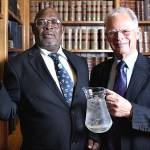Physics
“And you may find yourself in another part of the world.
And you may find yourself behind the wheel of a large automobile.
And you may find yourself in a beautiful house, with a beautiful wife.
And you may ask yourself, ‘Well, how did I get here?’” -Talking Heads
Well, imagine it's happened: an apocalypse, at least for you. You awaken without knowing where you are, how you got there, or even what year it is.
Image credit: ©2010–2015 SamuraiSunshine; photography from deviantART.
And for some reason, what you need to figure out is exactly where you are on Earth: your latitude and longitude…
Have you ever thought about what "nothing" truly is? We used to think about it in terms of simply removing all the particles from a given region of space, which is a pretty intuitive definition of nothing. But quantum physics is notorious for defying our intuition.
Public domain image.
When we take a look at this "empty" space, we find it's not so empty at all. Not in terms of energy, and not -- if we consider that particles are not just real but also virtual -- in terms of what's physically inside.
Image credit: Derek Leinweber.
If you've ever wondered about "nothing," take a trip with…
(When I launched the Advent Calendar of Science Stories series back in December, I had a few things in mind, but wasn't sure I'd get through 24 days. In the end, I had more than enough material, and in fact didn't end up using a few of my original ideas. So I'll do a few additional posts, on an occasional basis, to use up a bit more of the leftover bits from Eureka: Discovering Your Inner Scientist...)
Every physicist with the tiniest bit of a public profile gets letters from people with a pet theory to promote. These days, email and social media make it incredibly easy to flood the inbox of…
I've decided to do a new round of profiles in the Project for Non-Academic Science (acronym deliberately chosen to coincide with a journal), as a way of getting a little more information out there to students studying in STEM fields who will likely end up with jobs off the "standard" academic science track.
The fourteenth profile of this round (after a short hiatus for relentless book promotion) features the founder of a new crowd-funding platform for physics.
1) What is your non-academic job? I am the Founder and President of Fiat Physica, the world’s premiere physics fundraising platform.…
Two new items about Eureka: Discovering Your Inner Scientist:
1) WAMC has now posted the interview I did with Joe Donahue on The Roundtable. This was a fun interview, and covers a number of examples from the book, so I think gives you a really nice sense of what it's all about.
2) There's a review of Eureka in New Scientist, along with two other books. It's fun to see all these different publications do reviews, because every reviewer latches onto a different example to feature. You can almost deduce the entire contents of the book if you read all of the different reviews...
The New Scientist…
I exchanged a bunch of emails a week or two ago with a journalist who was working on a story involving the possibility of faster-than-light travel. He wanted me to check some statements about the relationship between FTL and causality. FTL creates problems for causality, because if you have an object moving faster than light, there will be pairs of observers who see events involving the FTL object happening in different orders, which means somebody will see an effect happen before its cause.
I talk about this is How to Teach Relativity to Your Dog using the example of a stationary dog, a…
“People are trapped in history and history is trapped in them.” -James A. Baldwin
We've come a long way since we first started watching the night skies. Even just a century ago, we thought our Universe was governed by Newtonian gravity and consisted only of our Milky Way and the stars inside.
Image credit: SDSS.
In the past 100 years, we've come to understand that our Universe is a vast, expanding-and-cooling space that formed planets, stars, galaxies and clusters from a past that was so hot and dense we didn't even have atoms, nuclei, or stable protons! There are a myriad of questions…
I've decided to do a new round of profiles in the Project for Non-Academic Science (acronym deliberately chosen to coincide with a journal), as a way of getting a little more information out there to students studying in STEM fields who will likely end up with jobs off the "standard" academic science track.
The thirteenth profile of this round (after a short hiatus for relentless book promotion) features Twitter's own Dr. Mathochist, a mathematician turned software engineer.
1) What is your non-academic job? I'm a software architect at a small company working on a mixture of contracted and…
Back in December, The Parable of the Polygons took social media by storm. It's a simple little demonstration of how relatively small biases can lead to dramatic segregation effects, using cute cartoon polygons. You should go read it, if you haven't already. I'll wait.
This post isn't really about that. I mean, it is, but it's using it for something dramatically different than the intended purpose of the post. You see, I am such a gigantic dork that when I looked at their toy model, the first thing that came to mind was physics.
(And, in fact, I sat on this post topic for the better part of a…
(When I launched the Advent Calendar of Science Stories series back in December, I had a few things in mind, but wasn't sure I'd get through 24 days. In the end, I had more than enough material, and in fact didn't end up using a few of my original ideas. So I'll do a few additional posts, on an occasional basis, to use up a bit more of the leftover bits from Eureka: Discovering Your Inner Scientist...)
One of my very favorite stories about a famous physicist concerns a young man of about 19, arriving at Cambridge from the University of Edinburgh. While being introduced around the college, it…
I've decided to do a new round of profiles in the Project for Non-Academic Science (acronym deliberately chosen to coincide with a journal), as a way of getting a little more information out there to students studying in STEM fields who will likely end up with jobs off the "standard" academic science track.
The twelfth profile of this round (after a short hiatus for relentless book promotion) features a distinguished Union Physics alumnus, now a business analyst in New Jersey.
1) What is your non-academic job? I work at the Princeton, NJ office of ZS Associates, a company that describes…
Over on Facebook, my colleague Chris Chabris was talking up a smartphone game from a company he's associated with. Which of course got me thinking "Wait, why don't I have a smartphone game company?" (The Renaissance Weekend is also partly to blame, as I was one of about six people there who didn't have a start-up company of some sort...) Which, in turn, led to the realization that there really ought to be a quantum optics video game. Or maybe a series of games, because you could construct a whole bunch of puzzlers around quantum phenomena:
-- The most basic would be to do something like the…
"Hey," you say, "It's been, like, a week and a half since you did a post flogging Eureka: Discovering Your Inner Scientist. What gives?" Well, I've been kind of busy, and also the media world sort of goes into suspended animation over the stretch between Christmas and New Year's.
However, there's publicity stuff in the works. Specifically, the interview I recorded with Joe Donahue for The Roundtable on WAMC will probably air today. I'm not sure exactly when-- the show runs from 9am to noon, but I would bet on some time between 10:20 and 11:45, because I'm teaching a class then.
Anyway, it's…
One of the joys of the holidays and the University turning off the heating and locking us out, is that it provides time to catch up on things: papers, refereeing, recommendation letters, grading, syllabi, proposals, all the stuff one can rarely get to during actual working semester hours.
And, sometimes, there is time for real life: casual reading, family, catching up online...
One of the ye olde blog things I like to look over occasionally is Scott Aaronson's shtetl-optimized, for the latest on P!=NP news, or polemic on quantum computing.
This time, what caught my eye was his take on the…
One of my Christmas gifts this year was a Seek Thermal camera, so I can continue my transformation into Rhett Allain. What's this for? Why, physics, of course. Such as this video of the operation of the Christmas pyramid my parents picked up in Germany, and had set up at the start of Christmas dinner:
Sadly, the Seek Thermal app doesn't seem to record audio with the video, so you miss out on SteelyKid's running commentary about the whole thing... But you can fairly clearly see the plumes of hot air rising up from the candle to push the vanes of the fan. There's probably a way to estimate the…
For the penultimate advent calendar of science stories post, we'll turn to a great experimentalist with a great biography. This story also appears in Eureka: Discovering your Inner Scientist, but it's too good not to re-use.
Chien-Shiung Wu was born in china in 1912, at right around the time education of women was first legalized. Her father founded a school for girls so he could teach her, then at around the age of 10 she went off to a boarding school, and then the best universities in the country, where she distinguished herself as one of the finest math and physics students in China. At…
One of the very best books I ran across in the process of doing research for Eureka is The Second Creation: Makers of the Revolution in Twentieth-Century Physics by Robert P. Crease and Charles C. Mann. It's an extremely detailed treatment of the development of quantum theory, and includes anecdotes that I haven't seen elsewhere. It also does a fantastic job of showing the essential interplay of experiment and theory through the difficult process of developing quantum field theory, which is often underplayed in popular treatments (which tend to be written by theorists, and often treat…
Another weekend day, another story I'm going to outsource a bit. In this case, to the original scientist, who at the time of his discovery was a 13-year-old schoolboy in Tanzania:
In 1963, when I was in form 3 in Magamba Secondary School, Tanzania, I used to make ice-cream. The boys at the school do this by boiling milk, mixing it with sugar and putting it into the freezing chamber in the refrigerator, after it has first cooled nearly to room temperature. A lot of boys make it and there is a rush to get space in the refrigerator.
One day after buying milk from the local women, I started…














